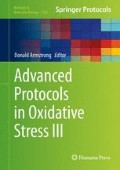Abstract
Numerous studies in the past decade have identified N-β-methylamino-l-alanine (BMAA) as a putative environmental neurotoxin. Produced by cyanobacteria and accumulated at different levels of the trophic system, BMAA has been detected in the brain tissue of human patients that died from progressive neurodegenerative disease. Research into the mechanism of neurotoxicity has been hampered by conflicting results and disagreement in the literature over analytical methods used for quantification and detection. While several research approaches have been tested, the use of the derivatizing reagent 6-aminoquinolyl-N-hydroxysuccinimidyl carbamate is presented here as an effective and selective means for the analysis of BMAA and two co-occurring biological isomers, DAB and AEG, by liquid chromatography and tandem mass spectrometry.
Access this chapter
Tax calculation will be finalised at checkout
Purchases are for personal use only
References
Arnold A, Edgren DC, Paladino VS (1953) Amyotrophic lateral sclerosis: fifty cases observed on Guam. J Nerv Ment Dis 117:135–139
Koerner DR (1952) Amyotrophic lateral sclerosis on Guam: a clinical study and review of the literature. Ann Intern Med 37: 1204–1220
Kurland LT, Mulder DW (1954) Epidemiologic investigations of amyotrophic lateral sclerosis. 1. Preliminary report on geographic distribution with special reference to the Mariana Islands, including clinical and pathologic observations. Neurology 4:438–448
Reed W, Plato C, Elizan T, Kurland LT (1966) The amyotrophic lateral sclerosis/parkinsonism-dementia complex: a ten year follow up on Guam. Am J Epidemiol 83:54–73
Whiting MJ (1963) Toxicity of cycads. Econ Bot 17:270–302
Vega A, Bell EA (1967) a-amino-methylamiopropionic acid, a new amino acid from seeds of Cycas circinalis. Phytochemistry 6:759–762
Ludolph A, Hugon J, Nunn PB, Roy DN, Spenser PS (1988) Clinical and electrophysiological features of the primate motor system disease induced by BMAA—a neurotoxin in the Guam Cycad plant. Electroencephalogr Clin Neurophysiol 69:P18
Duncan MW, Steele JC, Kopin IL, Markey SP (1990) 2-amino-3-(methylamino)-propanoic acid (BMAA) in cycad flour: an unlikely cause of amyotrophic lateral sclerosis and Parkinsonism-dementia of Guam. Neurology 5:767–772
Cox PA, Sacks OW (2002) Cycad neurotoxins, consumption of flying foxes, and ALS-PDC disease in Guam. Neurology 58:956–959
Cox PA, Banack SA, Murch SJ (2003) Biomagnification of cyanobacterial neurotoxins through the ecosystem: implications for ALS-PDC in Guam. Proc Natl Acad Sci U S A 100(23):13380–13383
Cox PA, Banack SA, Murch SJ, Rasmussen U, Tien G, Bidigare RR, Metcalf JS, Morrison LF, Codd GA, Bergman B (2005) Diverse taxa of cyanobacteria produce beta-N-methylamino-L-alanine, a neurotoxic amino acid. Proc Natl Acad Sci U S A 102:5074–5078
Murch SJ, Cox PA, Banack SA, Steele JC, Sacks OW (2004) Occurrence of ß-methylamino-l-alanine (BMAA) in ALS/PDC patients from Guam. Acta Neurol Scand 110:267–269
Pablo J, Banack SA, Cox PA, Johnson TE, Papapetropoulos S, Bradley WG, Buck A, Mash DC (2009) Cyanobacterial neurotoxin BMAA in ALS and Alzheimer’s disease. Acta Neurol Scand 120:216–225
Lobner D, Piana PM, Salous AK, Peoples RW (2007) β-N-methylamino-l-alanine enhances neurotoxicity through multiple mechanisms. Neurobiol Dis 25:360–366
Liu XQ, Rush T, Zapata J, Lobner D (2009) β-N-methylamino-l-alanine induces oxidative stress and glutamate release through action on system Xc−. Exp Neurol 217:429–433
Rao SD, Banack SA, Cox PA, Weiss JH (2006) BMAA selectively injures motor neurons via AMPA/kainate receptor activation. Exp Neurol 201:244–252
Cucchiaroni ML, Viscomi MT, Bernardi G, Molinari M, Guatteo E, Mercuri NB (2010) Metabotropic glutamate receptor 1 mediates the electrophysiological and toxic actions of the cycad derivative {beta}-N-Methylamino-L-alanine on substantia nigra pars compacta DAergic neurons. J Neurosci 30:5176–5188
Chiu AS, Gehringer MM, Braidy N, Guillemin GJ, Welch JH, Neilan BA (2013) Gliotoxicity of the cyanotoxin, β-methyl-amino-L-alanine (BMAA). Sci Rep 3:1482. doi:10.1038/srep01482
Esterhuizen-Londt M, Pflugmacher S, Downing TG (2011) The effect of b-N-methylamino-L-alanine (BMAA) on oxidative stress response enzymes of the macrophyte Ceratophyllum demersum. Toxicon 57:803–810
Glover WB, Murch SJ (2013) Analysis of ß-methylamino-l-alanine for environmental and food samples. Recent Adv Phytochemistry 44:149–174
Cohen SA (2012) Analytical techniques for the detection of a-amino-b-methylamino-propionic acid. Analyst 137:1991–2005
Banack SA, Downing TG, Spácil Z, Purdie EL, Metcalf JS, Downing S, Esterhuizen M, Codd GA, Cox PA (2010) Distinguishing the cyanobacterial neurotoxin β-N-methylamino-L-alanine (BMAA) from its structural isomer 2,4-diaminobutyric acid (2,4-DAB). Toxicon 56:868–879
Banack SA, Metcalf JS, Jiang L, Craighead D, Ilag LL, Cox PA (2012) Cyanobacteria produce N-(2-aminoethyl)glycine, a backbone for peptide nucleic acids which may have been the first genetic molecules for life on Earth. PLoS One 7:e49043
Glover WB, Liberto CM, McNeil WS, Banack SA, Shipley PR, Murch SJ (2012) Reactivity of β-methylamino-L-alanine in complex sample matrices complicates detection and quantification by mass spectrometry. Anal Chem 84: 7946–7953
Author information
Authors and Affiliations
Corresponding author
Editor information
Editors and Affiliations
Rights and permissions
Copyright information
© 2015 Springer Science+Business Media New York
About this protocol
Cite this protocol
Glover, W.B., Cohen, S.A., Murch, S.J. (2015). Liquid Chromatography and Mass Spectrometry for the Analysis of N-β-Methylamino-l-alanine with 6-Aminoquinolyl-N-Hydroxysuccinimidyl Carbamate. In: Armstrong, D. (eds) Advanced Protocols in Oxidative Stress III. Methods in Molecular Biology, vol 1208. Humana Press, New York, NY. https://doi.org/10.1007/978-1-4939-1441-8_27
Download citation
DOI: https://doi.org/10.1007/978-1-4939-1441-8_27
Published:
Publisher Name: Humana Press, New York, NY
Print ISBN: 978-1-4939-1440-1
Online ISBN: 978-1-4939-1441-8
eBook Packages: Springer Protocols

